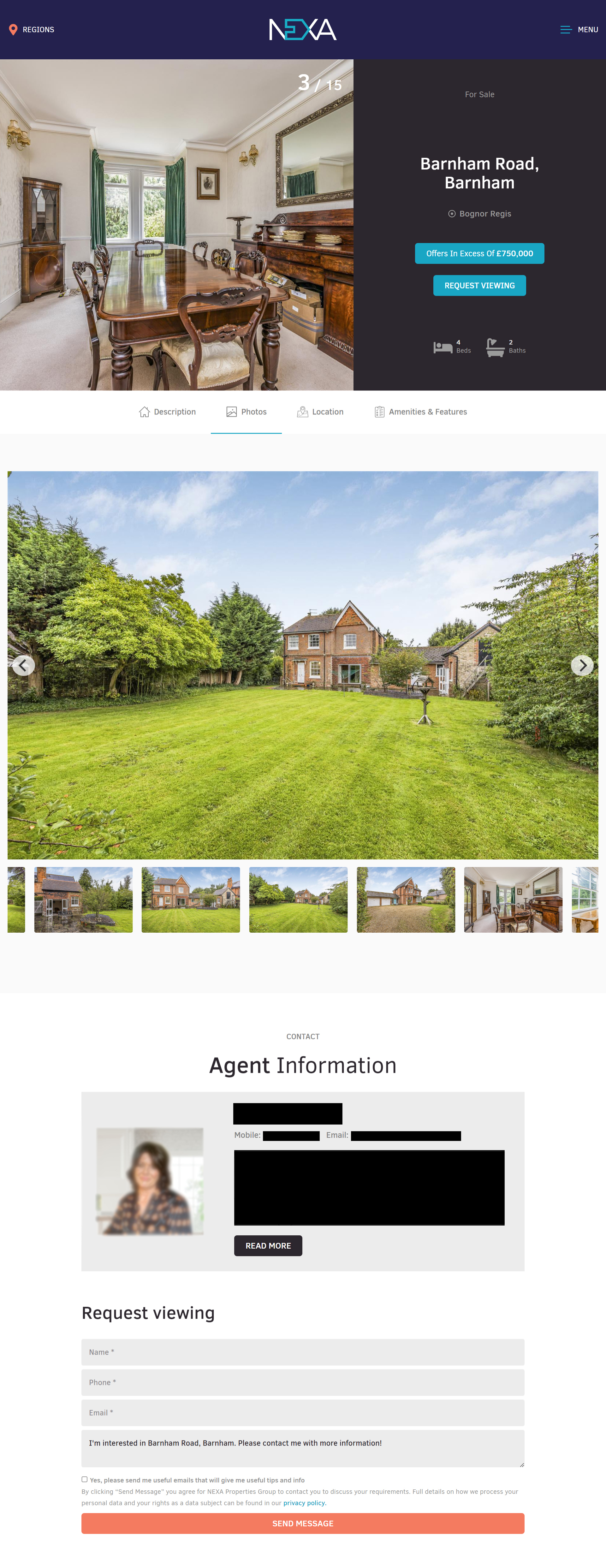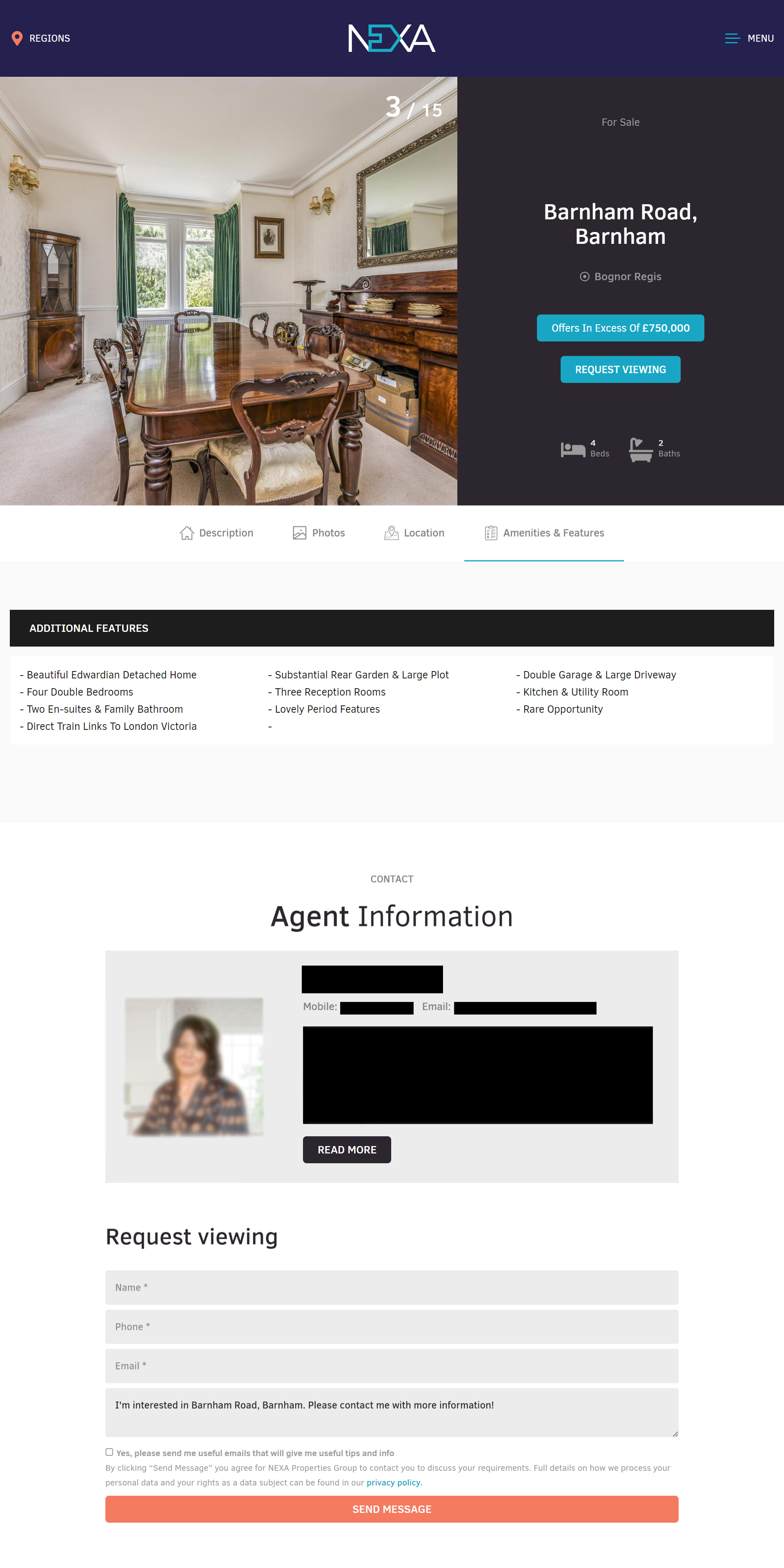Automatically pull property data from Jupix To An Estate Agency’s Website
Project Description:
Join me as I unveil the seamless automation journey undertaken at NEXA Properties, a premier estate agency in England, UK. Delve into the intricacies of integrating property data from Jupix directly onto our website. Discover the transformative benefits of this integration and how it revolutionized our operations, enhancing efficiency and customer experience alike.
Services Rendered:
- Web Design & Development
- API Integration
- Website Management & Maintenance
- Server Management & Maintenance
The overview
Objectives of the Project
Understanding the significance of property data integration
A seamless and efficient integration of property data is crucial for estate agencies. The ability to automatically pull property data from Jupix, a popular property management system, to your estate agency’s website can bring numerous advantages. By integrating property data, you can provide up-to-date information to potential buyers or renters, showcase your property portfolio, and streamline the overall experience for both your agency and clients.
What to expect from this showcase
I will guide you through the process we followed at NEXA Properties (An estate agency in England, UK) to achieve automatic property data pull from Jupix to the NEXA website. I will discuss how we set up Jupix property data integration, fetched property data from Jupix, integrated the data into the website, and highlight the benefits of this integration.
Building the concept
Setting Up Jupix Property Data Integration
Introduction to Jupix API and its functionalities
Before diving into the integration process, it’s essential to understand the purpose and functionalities of the Jupix API. The Jupix API allows developers to access property data stored in Jupix and retrieve it programmatically. It provides a set of methods and endpoints that enable seamless communication between your estate agency’s website and Jupix.
Exploring the purpose of Jupix API
The Jupix API serves as a bridge between the property management system and your estate agency’s website. It enables data synchronization and retrieval, allowing you to access property details, images, and other relevant information directly from Jupix.
Obtaining necessary credentials for API access
To integrate Jupix property data into the NEXA website, we needed to obtain the necessary credentials for API access. This involved obtaining API keys and access tokens from Jupix. These credentials authenticate the NEXA website’s requests and ensure secure communication with Jupix.
Configuring Jupix API settings
We then configured the API settings for the NEXA website. This involved setting up the required API keys and access tokens, specifying authorized IP addresses and domains, and implementing secure communication protocols.
1. Creating API keys and access tokens
We then created API keys and access tokens in Jupix. These credentials authenticated the NEXA website’s requests when accessing property data.
2. Setting up authorized IP addresses and domains
To ensure the security of the Jupix integration, it was crucial to specify the authorized IP addresses and domains that can access the API. By whitelisting these addresses and domains, we limited access to the NEXA website, preventing unauthorized usage of the API.
3. Implementing secure communication protocols
To safeguard the communication between the NEXA website and Jupix, we implemented secure communication protocols, such as HTTPS. By encrypting the data transmitted between the two systems, we protected against potential security vulnerabilities and ensured the integrity of the property data.
Understanding Jupix data endpoints
Jupix offers a range of endpoints that allowed us to retrieve specific sets of property data.
1. Identifying relevant endpoints for property data extraction
We explored the available Jupix endpoints and identified the ones most relevant to NEXA Properties. These endpoints included property listing details, property images, property descriptions, and other related information.
2. Investigating parameters and filters to refine property searches
To enhance the accuracy of property searches, Jupix provides various parameters and filters that allowed us to refine search criteria. Parameters include location, price range, property type, and more. This allowed us to customize property searches based NEXA clients’ requirements.
3. Comprehending data format options (XML, JSON, etc.)
Jupix offers multiple data format options, such as XML, JSON, and others. Considering factors such as ease of parsing, compatibility with our chosen programming language, and performance, we made the informed decision to use XML data format.
Fetching Property Data from Jupix
Establishing data retrieval methods
There are several approaches we could have taken to establish the methods for retrieving property data from Jupix:
1. Utilizing direct API requests
One option was to make direct API requests to Jupix endpoints using programming languages like PHP, or JavaScript. This approach required some coding knowledge but provided flexibility and control over the data retrieval process.
2. Working with client libraries and SDKs
Another approach would have been to leverage client libraries or SDKs (Software Development Kits) provided by Jupix. These libraries abstract the underlying API calls, simplifying the integration process. They often include pre-built functions for common tasks, such as property search or data retrieval.
3. Exploring third-party integration options
Alternatively, we could have used third-party integration options that offer pre-built solutions for integrating Jupix property data into a website. These solutions often provide a user-friendly interface and require minimal coding knowledge.
After thoroughly evaluating all pros, cons and compatibility with the NEXA website’s requirements, we made the informed decision to utilize direct API requests for retrieving property data from Jupix.
Implementing data extraction techniques
To extract property data effectively, it was important to implement appropriate data extraction techniques. Considering the nature of NEXA’s property portfolio and website’s functionality, we needed to retrieve property details in bulk.
1. Pulling comprehensive property data using batch requests
The NEXA website required comprehensive property information, we used batch requests to fetch multiple property details simultaneously. Batch requests optimize the retrieval process for larger datasets, this allowed us to retrieve multiple properties efficiently in a single API call.
2. Handling pagination and large data sets efficiently
When dealing with large property datasets, pagination becomes crucial to manage the retrieval process effectively. We implemented a pagination technique to retrieve data in smaller, manageable chunks, ensuring optimal performance and responsiveness.
Improving search accuracy with filters and parameters
To provide accurate property search results on the NEXA website, it was important to make use of filters and parameters offered by the Jupix API.
1. Applying search filters (location, price, property type, etc.)
We leveraged search filters to enhance the accuracy of property search results. Filters included location, price range, property type, number of bedrooms, and more. By allowing users to apply these filters, you can help them find properties that align with their specific requirements.
2. Incorporating specific data parameters (number of bedrooms, bathrooms, etc.)
In addition to filters, we incorporated specific data parameters to further refine property searches. These parameters included the number of bedrooms, bathrooms, square footage, and other detailed property attributes. Customizing search parameters enables users to specify their preferences accurately.
3. Combining filters and parameters for precise property data extraction
To achieve precise property data extraction, we combined search filters and parameters strategically. This powerful combination allows users to narrow down their search criteria effectively and obtain search results tailored to their needs.
Integrating Property Data into Your Estate Agency’s Website
Designing an intuitive user interface for property listings
After we integrated Jupix property data into the NEXA website, we designed an intuitive user interface (UI) for property listings. A well-designed UI enhances user experience and showcases your property portfolio effectively.
1. Displaying property details and high-resolution images
We ensured that your property listings display key details, such as property descriptions, price, location, and other relevant information. We incorporated high-resolution images to captivate potential buyers or renters, allowing them to visualize the properties accurately.
2. Implementing interactive maps to showcase property locations
To provide valuable context to NEXA property listings, we implemented interactive maps that showcase the locations of the properties. This feature allows users to explore the surrounding area, nearby amenities, and assess the property’s proximity to essential landmarks.
3. Including relevant filters and sorting options for enhanced user experience
To empower the website’s users and simplify their property search experience, we included relevant filters and sorting options. These features allow users to customize their property searches further and view listings in a preferred order, such as by price, location, or property type.
Ensuring real-time data updates and synchronization
To keep NEXA property listings up to date and ensure a seamless user experience, it was crucial to establish real-time data updates and synchronization.
1. Establishing periodic data synchronization routines
We set up periodic data synchronization routines to ensure that NEXA property listings reflect the latest updates from Jupix. This ensures that potential buyers or renters have access to accurate and reliable information and avoids any inconsistencies or outdated data on the website.
2. Handling data conflicts and ensuring consistency
In the event of data conflicts or inconsistencies between the NEXA website and Jupix, we established protocols to handle these situations effectively. This involved implementing automated processes to prioritize certain data sources.
3. Implementing error handling mechanisms and alerts
Finally, we implemented error handling mechanisms and alerts to monitor the data synchronization process continuously. This allowed us to identify and address any issues promptly, ensuring that NEXA property listings remain accurate and accessible.
Impressive result

Benefits of automating property data synchronization with Jupix
Automating the synchronization of property data with Jupix revolutionized the NEXA website. By pulling property data automatically, we saved valuable time and resources, eliminated the need for manual data entry, and ensured the accuracy of property information. Moreover, it allowed for real-time updates, ensuring that potential buyers or renters have access to the most current and relevant information about available properties. This automation also enhanced the user experience, making it easier for clients to navigate and explore the properties on the website.






